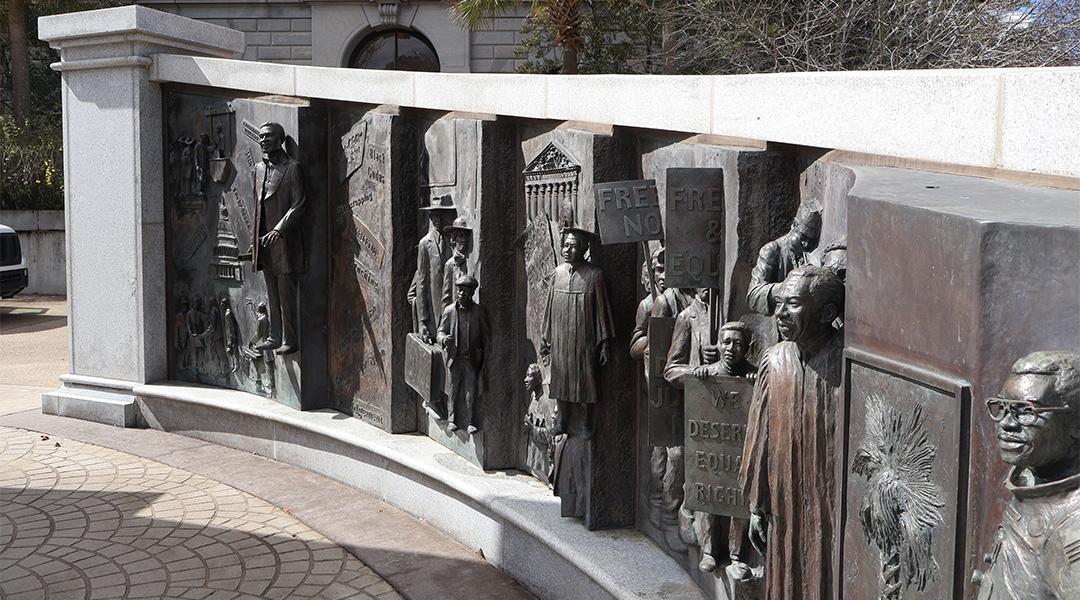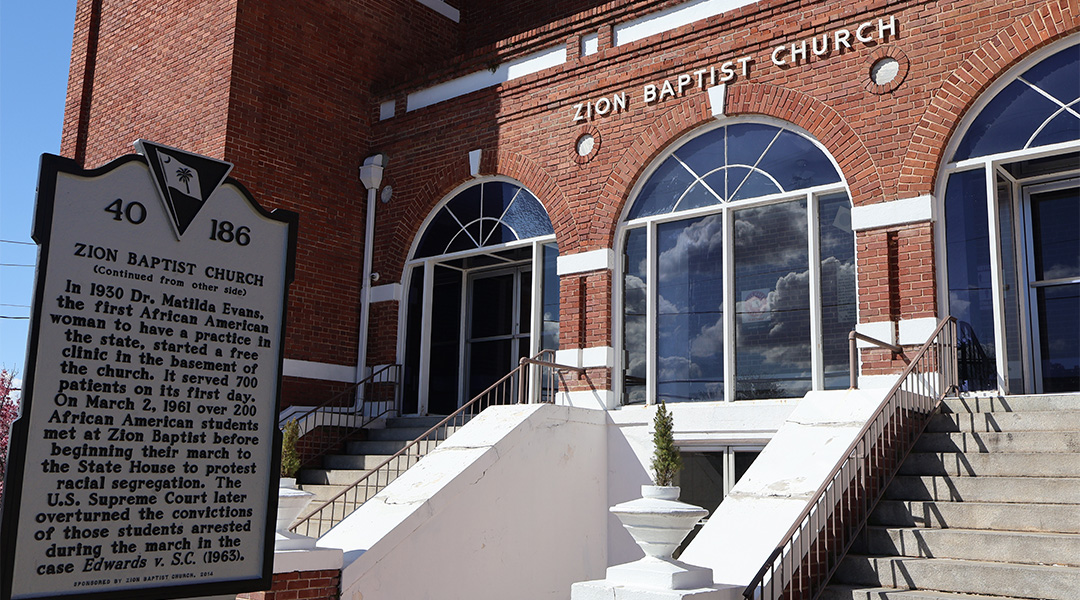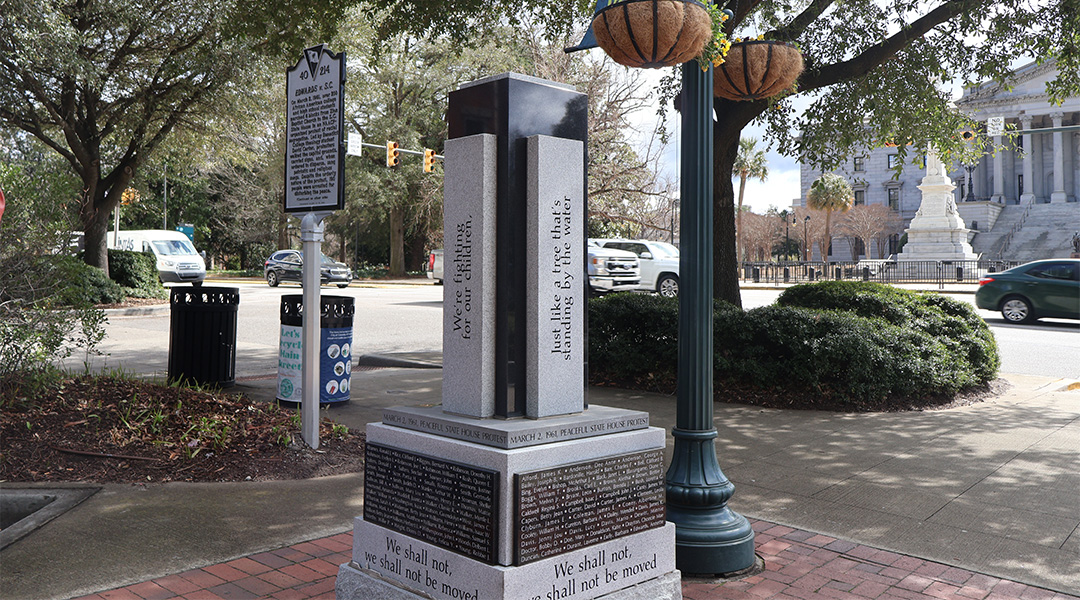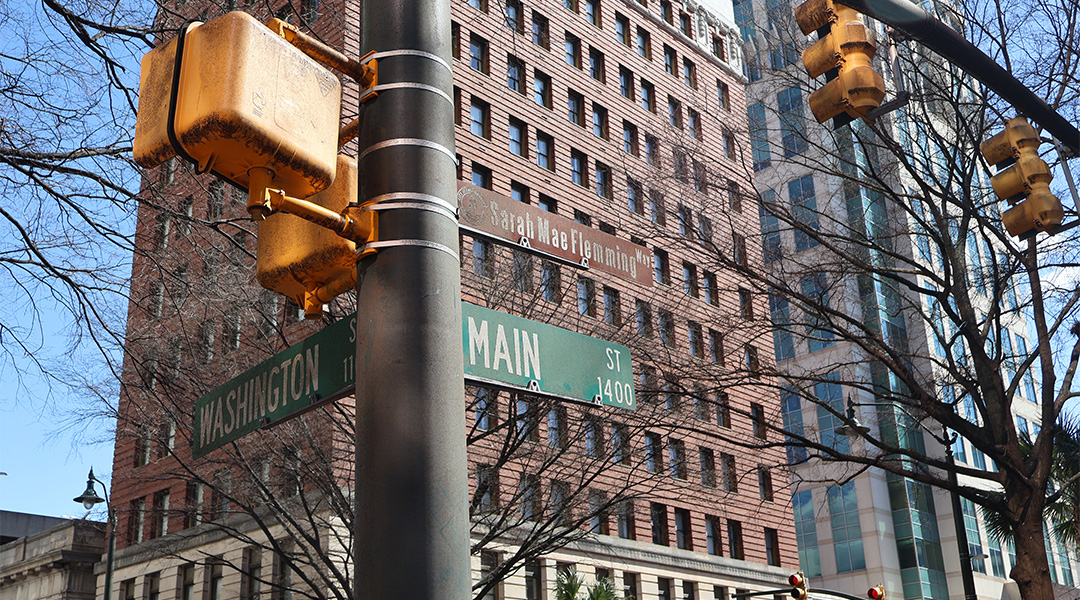The Black history monument by sculptor Ed Dwight on the Statehouse grounds (Photos by Emmy Ribero)
Columbia 63 aims to draw attention to the gems in Columbia’s Black history – stories that are remarkable but unfamiliar.
The organization was founded by USC professor Bobby Donaldson to collect more thorough research on the year 1963 in the Civil Rights Movement and explore ways to present its research to the public.
With its work, the group has been able to call to light how important Columbia’s civil rights history was in the national scale, something organizers consider overlooked.
“When you think about civil rights, you typically think about Georgia, you think about Selma, Mississippi, you don’t think about Columbia, South Carolina,” said Jonathan Johnson, a project coordinator for Columbia 63. “And part of the goal was to kind of uncover these stories of what happened. Many people knew there was a civil rights movement in Columbia. But it wasn’t necessarily widely talked about at that time.”
The organization has been responsible for putting historical markers around Columbia to draw attention to important local history.
A historical marker on Washington Street is dedicated to Sarah Mae Flemming.
She was a domestic worker and boarded the bus in 1954 to get to work like she did every day. She took a seat and was yelled at by the driver to get up. When she tried to get off at the next stop, the driver punched her.
“And her case goes all the way to the (U.S.) Supreme Court. The case is known as Fleming v. SCE&G,” Johnson said.
That case set the precedent for Rosa Parks’ case, said Darnell Holland, a Main Street tour guide for Columbia 63.
“Rosa Parks and her teams and her attorneys are following the Sarah Mae Flemming case,” he said. “They knew about it very well. And they’re using the Sarah Mae Flemming case here in Columbia as a precedent to articulate and make the arguments that they’re going to make in representing Rosa Parks.”
Columbia 63 also put a marker and monument on the corner of Main and Gervais streets to recognize the 187 students arrested and charged with breach of the peace on Statehouse grounds for protesting peacefully in 1961 against segregation.
Columbia attracted national attention with a court case that further protected the right to protest peacefully. Many demonstrators were students at HBCUs such as Columbia’s Allen University and Benedict College, according to librarian Margaret Dunlap, Richland Library’s local history manager.
Dunlap said the young generation was “restless to speak out and act against (segregation).”
“It wasn’t a riot, or breach of peace,” she said. “The charge, really, was not applicable to their behavior.”
The case became James Edwards Jr., et al, vs. the State of South Carolina and also made it all the way to the U.S. Supreme Court, where the charges were dismissed.
“It’s now part of the case law that will protect people who are peacefully demonstrating against a policy or practice without (cause),” Dunlap said. “You know, that is a freedom that we now all share.”
Attorneys from Spartanburg, Matthew J. Perry and Lincoln Jenkins, represented both Flemming and the Statehouse demonstrators.
In an interview with the Smithsonian magazine, Perry recalled an experience he had when serving in the military and traveling home by train. He had to switch trains in Birmingham, where he wanted to get something to eat, when he noticed that Italian prisoners of war were able to eat in the restaurant but he was not, even after he had served his country.
“Here I was at that time an American soldier,” Perry said. “I was wearing the uniform of my country. … But here I was denied a privilege, once again. It was not strange to me. But now a sort of feeling of insult began to develop within me.”
His experiences with injustice inspired him to join a field that would help him better understand the reasoning behind his experiences and find a solution. That led him to the law.
“The injustice of it all I think became more clear, and I wondered about its justification,” he said. “I wondered if anything could be done about it. I had not been trained in the law. So therefore I had not come upon any solutions in my mind.”
Columbia’s federal courthouse on Park Street is now named after Perry, who died in 2011.
During Black History Month, Columbia 63 is doing free Main Street walking tours. Main Street was a white business district that witnessed heavy segregation.
One of the markers there now tells of how a student named Simon Bouie, inspired by the Greensboro Four, performed similar demonstrations such as sit-ins in Columbia’s white business district. On this marker, a quote from him reads, “It sharpened the movement. … We kept the fire going.”
There were many such demonstrations across Columbia. Another notable one sparked the case Barr v. the City of Columbia because of a sit-in performed by Benedict College students at Taylor Street Pharmacy.
Columbia’s Black business district was adjacent to Main Street, on Washington Street. It’s commemorated by a marker at Washington and Park streets but also a mural by local artist Ija Charles on Main Street.
There’s also an exhibit in the Columbia Museum of Art dedicated to the Black business district. Only a few still stand, including Zion Baptist Church, which played a prominent role in the movement.
The demonstrators met at the church in 1961 before heading to the Statehouse.
The church served as a meeting place for organizations like the NAACP and in the 1960s was considered a “cornerstone of Columbia’s civil rights movement and a safe haven for student activists who participated in downtown demonstrations,” according to the Columbia 63 marker there.
An additional exhibit in the Columbia Museum of Art uses photographs, newspaper clippings, maps and historical artifacts to share stories of what it was like to be a Black American in Columbia at the time of Reconstruction.
Included in the exhibit are many notable figures in Columbia. One of them was Celia Dial Saxon.
Saxon was an educator at Columbia’s Booker T. Washington High School, the largest public high school for Black students.
She taught at all levels, from elementary to collegiate. And she was a community leader, providing Black students with resources and education while working to make segregated schools as equitable as possible, according to a Columbia City of Women entry on Historic Columbia’s website.
“A teacher there was being basically a leader in the African-American community,” Dunlap said.
She had an elementary school named after her as well as housing complexes.
For Johnson, remembering icons such as Saxon and Flemming with markers and memorials serves Columbia 63’s mission to uncover these stories.
“It’s important to do this work because now we’re able to get a much fuller story, instead of a story that was kind of tailored to paint Columbia in a light that favors only certain populations,” he said.
Johnson said the group wants to spread awareness of Black history because acknowledging history is important to understanding society today.
“It’s important to look at our history because if we don’t, we don’t understand the impact of why we do what we do and how we came to be the way we are today,” Johnson said. “And so if we don’t look at it, we’ll never be able to learn from mistakes and never be able to progress in the ways that we need to socially.”
Zion Baptist Church was an important gathering place for civil rights activists.
A monument commemorating the names of the 1961 Statehouse demonstrators by Columbia 63
The corner of Main and Washington, an honorary street named for Sarah Mae Flemming
Photographs of important local figures featured in the Columbia Museum of Art exhibit entitled “Intersection on Main Street, African American Life in Columbia”






